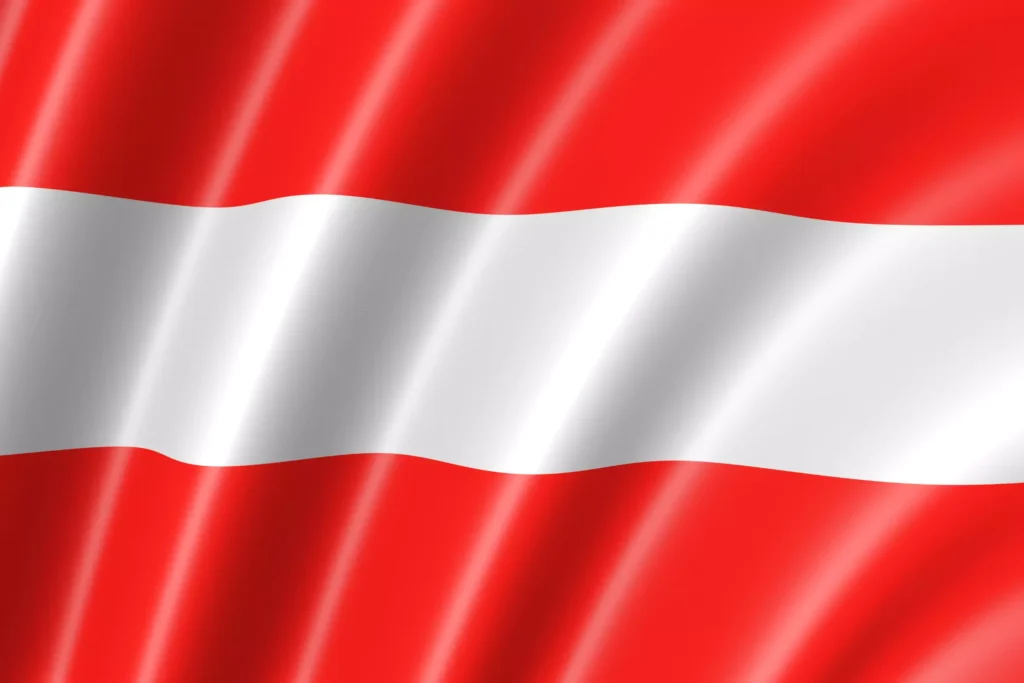The Austria flag has developed over centuries of rich history, with the iconic red-white-red tricolor design greatly connected to Austrian identity. Learn the origins of the flag during Medieval Austria, and the symbolic meaning behind the red-white-red stripes.
General Information About Austria
Country Information
- Location: Central Europe
- Capital: Vienna
- Population: 8.9 million (2020 estimate)
- Language: German
- Government: Federal parliamentary republic
- Currency: Euro
- Economy: $51,900 (2019) GDP per capita
- Religion: Christians
Neighboring Countries of Austria
Table of Content
Flag History of Austria
Austria Kingdom during the Middle Ages
Color Of Austria Flag
Symbolism of the Flag of Austria
Frequently Asked Questions
Flag history of Austria
Austria has a long and rich history that is reflected in the evolution of its national flag over the centuries. The red-white-red tricolor flag is deeply ingrained as a symbol of Austrian identity and nationalism.
Austria Kingdom during the Middle Ages
During the Middle Ages, Austria was an independent duchy within the Holy Roman Empire ruled by the House of Babenberg. The coat of arms during this period consisted of a black eagle on a gold background. When the Babenberg dynasty ended in 1246, Austria came under the control of the Habsburg family. The Habsburg coat of arms had a red-white-red shield, which eventually became associated with Austria.
Color Of Austria Flag

The current flag of Austria was officially adopted in 1918 after the fall of the Austro-Hungarian Empire. The colors are red-white-red, with the red at the top and bottom of equal width and a broader white stripe in the middle. The red represents strength and valor, while the white symbolizes wisdom and integrity. Red and white were the colors used by the Duchy of Austria during the Middle Ages.
Symbolism of the Flag of Austria
The Austrian flag represents the pride and nationalism of the country. While the red-white-red tricolor was used unofficially since the 17th century, it only became the official national flag in 1918 after World War I and the end of the Habsburg monarchy. The breakup of the Austro-Hungarian empire allowed Austria to reaffirm its separate identity. The flag has come to symbolize the freedom and sovereignty of the Austrian Republic. The balanced use of red and white demonstrates the equilibrium between wisdom and courage valued by the Austrian people.
Frequently Asked Questions
When was the current Austrian flag first used?
A: The modern horizontal triband design was officially adopted in 1918 after the fall of the Austro-Hungarian Empire, but variants of the red-white-red flag had been used since the 13th century.
What do the colors on the Austrian flag represent?
A: Red represents strength, courage and the blood spilled by Austrians to defend their country. White represents wisdom, peace, and integrity.
How many stars are on the Austrian flag?
A: The Austrian flag does not contain any stars. Some people confuse it with the flag of Australia, which has six stars.
What dynasty ruled Austria during the Middle Ages?
A: The Babenberg dynasty was the first to rule Austria as a duchy and later elevated it to an archduchy during the Middle Ages. They ruled from 976 to 1246.
What major empire controlled Austria before 1918?
A: From 1804 to 1867, Austria was part of the Austro-Hungarian Empire ruled by the Habsburg dynasty. Austria was the predominant and more influential part of the dual monarchy.
When did the House of Habsburg start ruling Austria?
A: The Habsburgs rose to power in Austria in 1282 and ruled until the fall of the Austro-Hungarian Empire in 1918, making it one of the longest-ruling dynasties in European history.
Who was the last Habsburg emperor of Austria?
A: Emperor Charles I reigned from 1916 until 1918 when the empire collapsed following Austria’s defeat in World War I. He was the last Habsburg to rule Austria and the Austro-Hungarian empire.




